
About UsThe Numismatic Bibliomania Society is a non-profit organization promoting numismatic literature. For more information please see our web site at coinbooks.org SubscriptionsThose wishing to become new E-Sylum subscribers (or wishing to Unsubscribe) can go to the following web page link MembershipThere is a membership application available on the web site Membership Application To join, print the application and return it with your check to the address printed on the application. Membership is only $15 to addresses in the U.S., $20 for First Class mail, and $25 elsewhere. For those without web access, write to: David M. Sundman, Secretary/TreasurerNumismatic Bibliomania
Society AsylumFor Asylum mailing address changes and other membership questions, contact David at this email address: dsundman@LittletonCoin.com SubmissionsTo submit items for publication in The E-Sylum, just Reply to this message, or write to the Editor at this address: whomren@coinlibrary.com
BUY THE BOOK BEFORE THE COINYou won't regret it! |
- WAYNE'S WORDS: THE E-SYLUM JULY 15, 2012
- NEW BOOK: CANADIAN COIN DIGEST, 2ND EDITION
- BOOK REVIEW: LA MONNAIE EN CIRCULATION EN FRANCE SOUS NAPOLÉON
- BOOK REVIEW: HISTORY OF COLLECTING CONFEDERATE STATES PAPER MONEY
- BOOK REVIEW: THE SECRET OF THE GOOD SAMARITAN SHILLING
- DOUG WINTER REMEMBERS DAVID AKERS
- MORE ON MONTROVILLE DICKESON
- NOTES FROM E-SYLUM READERS: JULY 15, 2012
- COINS FOUND AT SITE OF DE SOTO'S 1539 FLORIDA ENCAMPMENT
- STOLEN VALOR RULING PROMPTS CREATION OF MEDAL DATABASE
- DAVID GANZ ON LEGAL TENDER AND SPENDING MONEY
- BANK OF PORTUGAL 20 ESCUDOS BANKNOTE AND MEDAL
- REVIEW: THE NEW PHILADELPHIA MINT EXHIBIT AND TOUR
- WAYNE'S NUMISMATIC DIARY: JULY 15, 2012
- MORE ON MEDAL CABINET LINING MATERIALS
- CRUSADERS' GOLD COIN HOARD FOUND IN ISRAEL
- URSULA KAMPMANN'S NUMISMATIC VISIT TO JERUSALEM. PART II
- A DANIEL IN THE LION’S DEN MEDAL
- NEW BRISTOL POUND LOCAL CURRENCY DESIGNS UNVEILED
- 19TH CENTURY BRAZILIAN PATTERNS STRUCK IN WOOD
- AN OPEN LETTER TO THE NEW ANA EXECUTIVE DIRECTOR
- ARTISTS USES MONEY ITSELF AS HIS MEDIUM
- FEATURED WEB SITE: NUMISMATIC SOCIETY OF CALCUTTA
WAYNE'S WORDS: THE E-SYLUM JULY 15, 2012

New subscribers this week include Cole Schenewerk and Ermin Chow, courtesy of RyAnne Scott, Joe Usibelli and Jay Recher. Welcome aboard! We have 1,572 email subscribers, plus 183 followers on Facebook.
This week we open with one new book announcement and three reviews. Other topics include David Akers, new archeological coin finds, SOBs, Geezer Numismatists and pattern coins struck in wood.
To learn more about the cod wars, Montroville Dickeson's 1793 cents, one the greatest Confederate currency collectors of all time, and one of the “bestest” numismatic books you’ll ever read, read on. Have a great week, everyone!
Wayne Homren
Editor, The E-Sylum
NEW BOOK: CANADIAN COIN DIGEST, 2ND EDITION
 Canadian Coin Digest, 2nd Edition is now available from Krause Publications.
Canadian Coin Digest, 2nd Edition is now available from Krause Publications.
Mass marketing efforts by the Royal Canadian Mint have increased awareness of coin collecting in Canada. With the RCM continuing to produce and distribute a variety of attractive, timely-themed commemorative coins every year, Canadian collectors are looking for a reference to identify and price their collections. Canadian Coin Digest is beginner-friendly, a more concise, more affordable alternative to similar products currently on the market.
Edited by acclaimed experts Tom Michael and George Cuhaj, this book offers:
- Canadian coin identification and pricing by the world leaders in coin catalogs
- Thousands of up-to-date price listings on bullion coins which have greatly increased in value
- A resource for professionals and individuals wary of equities and other traditional investments who are using commemorative coins, rare coins, and bullion more and more as investment vehicles
Canadian Coin Digest, 2nd Edition is available at bookstores, and online at www.shopnumismaster.com.
BOOK REVIEW: LA MONNAIE EN CIRCULATION EN FRANCE SOUS NAPOLÉON
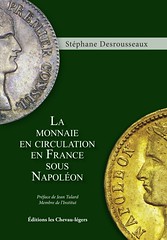 Desrousseaux, Stéphane. La monnaie en circulation en France sous Napoléon. Paris: Éditions Les Chevau-légers, 2012. French language. Softbound; 14.8 × 21.0 cm; illustrated in colour; 666 pages. ISBN 978-2-916996-44-8. Price: 48 euro.
Desrousseaux, Stéphane. La monnaie en circulation en France sous Napoléon. Paris: Éditions Les Chevau-légers, 2012. French language. Softbound; 14.8 × 21.0 cm; illustrated in colour; 666 pages. ISBN 978-2-916996-44-8. Price: 48 euro.
Beware! This is not a catalogue but a history textbook. In it, Mr. Desrousseaux, a doctor in Modern and Contemporary History from Université Paris-Sorbonne, shares his years of research in the First Empire, a pivotal period in the history of France. Indeed, he is the first one to so exhaustively study the subject, thanks to the use of numerous unpublished documents found in both the French National Archives and in those of Monnaie de Paris.
The book is divided in three parts in which one finds type study tables of the coins in circulation with actual-size, colour images of each coin.
In the first part, composed of seven chapters, the author dresses the portrait of the state of the currency on Bonaparte’s arrival in power. He then speaks of Bonaparte's vision for a standardized currency and of the difficulties the Emperor and his administration faced following the monetary reform of Year XI.
The author than studies, in the five chapters of the second part, the use of coinage in propaganda and in the conditioning of the public psyche. He therefore studies the types of the period and the progresses made in coinage, and concludes with a study of the money supply in circulation then.
Finally, Part 3 covers the use of coinage as a tool of domination in the territories annexed to France.
An impressive commented, topical bibliography completes the work.
All in all, a superb book well worth the 48-euro price for those that specialize in this period. My rating: 5/5. It is available directly from the publisher at www.numishop.eu/boutique-lib-livres_numismatiques_neufs_et_anciens.html
BOOK REVIEW: HISTORY OF COLLECTING CONFEDERATE STATES PAPER MONEY
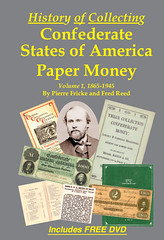 History of Collecting – Confederate States of America Paper Money, Volume 1, 1865 – 1945, By Pierre Fricke and Fred Reed, 2012, Copyright Pierre Fricke, Reviewed by: John and Nancy Wilson NLG
History of Collecting – Confederate States of America Paper Money, Volume 1, 1865 – 1945, By Pierre Fricke and Fred Reed, 2012, Copyright Pierre Fricke, Reviewed by: John and Nancy Wilson NLG
The recently released reference, History of Collecting – Confederate States of America Paper Money, Volume 1, 1865 – 1945, by Pierre Fricke and Fred Reed is a 340 page hardbound book with many full color illustrations. The Foreword was written by A. Hudson McDonald. McDonald stated, “Never had I realized there was such a history to the collecting of Confederate States of America (CSA) paper currency, nor appreciated the magnitude of the collectors, dealers, and sales quantities within this branch of numismatics during the time period 1865 – 1945.” The book has nine chapters, two appendixes, a bibliography, index and section about the authors. The reference includes a DVD which we will talk about later.
First Chapter: The Issue of CSA Paper Money. It started with the first sale of Confederate paper money by W. Elliot Woodward in NYC, on December 10, 1865. A $1000 Montgomery issue brought $4.75, and a $500 Montgomery $2.50. The CSA started in early 1861 to create bonds and paper money. Ten of the early notes are shown in color. Counterfeiting in the period of 1861-62 and solutions to this problem are discussed. It states that a complete type set of 70 regular issue notes would cost between $150,000 to $500,000.
Second Chapter: The First Collectors, 1865 - 1870s. Our good friend, Grover Criswell (1934-1999), laughingly told us about how he used to light his cigars using CSA notes. If still alive, we don’t think Grover would be doing that today. The early growth of the hobby started to evolve 1867 with advertisements in periodicals and many people making buying trips to the South in pursuit of CSA currency and bonds.
Early collectors were R. Alonzo Brock, Thomas Addis Emmet, who was the first cataloger of CSA currency and possessed 335 distinct varieties (which also included counterfeit and bogus issues). John Walter Scott, a stamp dealer, cataloger and numismatist. Scott’s “The Coin Collector’s Journal, Illustrated” commenced in 1875 and consisted of 13 volumes.
Third Chapter: Late 1870s and Early 1880s. The first decade of collecting CSA was labeled as the “hunter/gatherer” phase. Dr. William Lee (1841-1893) was the first serious cataloger of CSA currency. His reference “The Currency of The Confederate States of America was published in 1875 and only 30 copies were made. One of the early promoters of CSA currency was John W. Haseltine. The American Journal of Numismatics mentioned that in 1880 he was the foremost dealer in Confederate currency. Raphael Prosper Thian produced his rare and famous 1876 publication, “Confederate Note Album, For a Complete Collection,” of which only 25 were prepared. The 25 were filled with examples of CSA currency and given to dignitaries. An unknown amount of this publication were made (without notes enclosed) and sold to collectors.
Shortly after Thian published his, “Confederate Note Album, For a Complete Collection,” New York stamp dealer C. H. Bechtel issued a similar album in 1877. The Bechtel March 25, 1879 catalogue of J. E. Barratts collection is profusely covered with many illustrations of the lots along with their selling prices written in. CSA currency was so cheap at this time that businesses used actual notes and placed advertising on the blank backs. Another good friend of ours was Arlie Slabaugh, who left us some years back. Arlie was one of the first to comprehensively list known varieties of these advertising notes. His “Confederate States Paper Money” is now in its 13th Edition.
Fourth Chapter: More Action in the 1880s. By the 1880s, CSA material was red hot. Haseltine’s and Scott’s marketing practices worked. CSA President Jefferson Davis wrote a multi-volume reference in 1881, “In defense of the late war,” and his comments regarding CSA currency are interesting and thought provoking. Famous numismatists such as W. Elliot Woodward, Edouard Frossard, Charles Steigerwalt, The Chapman Brothers and Raphael Thian got involved.
Fifth Chapter: John C. Browne. Browne was one the greatest Confederate currency collectors of all time and had a CSA collection that contained more than 7,000 pieces. Part of the Browne collection was sold in 1922 by Stan V. Henkels.
Sixth Chapte: Late 1880s-1890s. An explosion of catalogs led to new discoveries, something desirable for both collectors and dealers. More numismatists are covered such as George Massamore, J. Thomas Scharf, the Scott Stamp and Coin Co. Edouard Frossard, Hiram Deats, Luther B. Tuthill, John A. Gill, Benjamin LaBree, Charles Barker, Lyman Low and William P. Titcomb.
Seventh Chapter: Early 1900s - Bradbeer Era. More information on Raphael P. Thian covers his employment in the Attorney General’s Office (AGO). He worked for the AGO for half a century passing in 1911. His work on Confederate Treasury Records while at the AGO “was largely obscure, and little heralded. Fortunately in 1944 his son Prosper sold many of these original compilations to Duke University, where they would be preserved and studied.”
According to the authors an important reference came into existence in 1901. Yale Professor John Christopher Schwab published a work “The Confederate States of America, 1861-1865: A Financial and Industrial History of the South During the Civil War”. In 1911 discussions were held on what to do with the vast stockpile of CSA notes in the hands of the U. S. Treasury Department. The gift by Archer M. Huntington to the American Numismatic Society in 1914 explains his donation of 2000 CSA notes to that society. One of the most prolific authors, William West Bradbeer wrote “Confederate and Southern States Currency” which was published in 1915 and became an immediate hit.
Eighth Chapter: Government Seizures of 1919. The complete story of this seizure of CSA notes by the Secret Service (because of fraudulent use), and the involvement of several prominent numismatists and coin clubs the government finally relented and buying and selling of CSA currency continued. We were also unaware of the Treasury Department’s destruction of 60 million CSA notes on May 1, 1920. The authors also provide information on the War Departments keeping their CSA notes.
Ninth Chapter: The 1920s - Early 1940s. Philatelist August Dietz, Sr. and his contributions to the understanding of engravers and printers of CSA currency is fully researched and covered along with photos. Numismatists, John E. Morse, David Todd, Wayte Raymond, Philip Chase, C. G. Memminger and D. C. Wismer are also discussed.
The early 1940s include the B. Max Mehl sale of the William F. Dunham collection which included CSA currency. Another important reference on the state of the CSA finances is covered with the reference by Professor Charles W. Ramsdell. In 1944 the professor authored “Behind the Lines in the Southern Confederacy.” The authors conclude that 65 years later “Ramsdell’s cogent arguments still mark his book as a classic.” Bradbeer’s 1915 work becomes the standard. Many important works by authors such as: The Chapman Brothers, Lyman Low, Thomas Elder, Lewis C. Gehring, William Hesslein, Milferd Henry Bolender, Barney Bluestone and the New Netherlands Coin Co (founded in 1936 by Moritz Wormser with his two sons and David Bullowa) are discussed.
A. “Notes on the Richmond Hoard.” The “Richmond Hoard” comprised 125 bankers boxes full of redeemed CSA currency with 5,500 notes in each box.
B. “CSA Paper Money Type Set.” Criswell Type 1 to Type 72 is illustrated along with Type XX1, XX2 T-47 and XX3 T-48.
The last and certainly not least is the wonderful DVD which is included in the back of the book. The DVD includes pictures of all the types of notes along with information about each note. Some of the rare notes also have all known serial numbers shown. The majority of all early auction catalogues are pictured with all pages and in some cases the prices realized. Many checklists are also shown in entirety. Fricke blogs are also shown.
We applaud Pierre and Fred for their comprehensive work and dedication on this reference. We think it will be a huge success in the numismatic hobby. It would be of help to a beginner as well as an advanced expert who collects or deals in CSA notes. We look forward to Part Two by these same authors in the months to come. We highly recommend this fantastic reference to everyone who has an interest in the monetary system of the South during the Civil War. The book may be ordered for $50 postpaid through the authors' websites www.csaquotes.com or www.fredwritesright.com .
BOOK REVIEW: THE SECRET OF THE GOOD SAMARITAN SHILLING
 Sylvester Sage Crosby’s The Early Coins of America illustrates two varieties of the rarest American colonial coin: the Massachusetts Good Samaritan shilling.
Sylvester Sage Crosby’s The Early Coins of America illustrates two varieties of the rarest American colonial coin: the Massachusetts Good Samaritan shilling.
Is the Good Samaritan shilling genuine? The answer — an emphatic “No” — was provided by the remarkable detective work of Eric P. Newman, in his The Secret of the Good Samaritan Shilling.
The shilling first surfaced in the United States when it appeared in the 1882 auction of the Charles Bushnell Collection, cataloged by brothers Henry and S.H. Chapman. Loren Parmelee of Boston bought it for $650 — the highest price of any coin in the auction, and also the approximate value of an 1804 dollar in 1882! Many collectors, however, smelled a rat.
One dealer, Ed Frossard, dismissed the Bushnell example as “bogus and modern.” Its reputation diminished, the Bushnell shilling next sold at auction, in 1890, for only $210. Yet, it was purchased by a respected numismatist, Hillyer Ryder, and was listed and illustrated in A Guide Book of United States Coins from 1947 to 1960 as a genuine Massachusetts silver coin pattern.
So was it real or bogus? Enter Mr. Newman, who in 1959 decided to solve the mystery.
I cannot do full justice, in a short column, to the brilliance of Eric’s investigations in exposing these two “shillings” as frauds (not “counterfeits” since there never had been such a thing as a genuine Good Samaritan shilling), but I can say that the impressive research is delivered with Eric’s signature dry wit that makes it a joy to read. For instance, he dismisses a struck copy of the Bushnell shilling as a “muled restrike of a reproduction of an erroneous drawing, copied from a conjured illustration of a genuine coin,” and concludes that all of this made it “the ‘fakest’ coin in history!” The Secret of the Good Samaritan Shilling is available from numismatic booksellers, and will be among the “bestest” numismatic books you’ll ever read!
To read the complete article, see: Newman exposes 'fakest' coin: The Good Samaritan 'shilling' (www.coinworld.com/articles/newman-exposes-fakest-coin/)

DOUG WINTER REMEMBERS DAVID AKERS
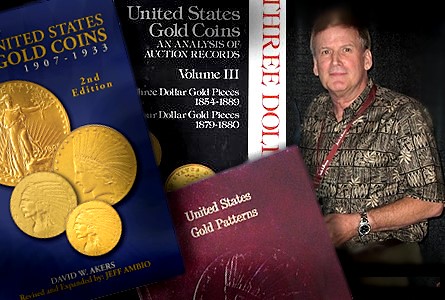
My interest in United States gold coins began early and, as a result, Dave Akers was one of my first numismatic heroes. I somehow managed to scam my way onto the Paramount mailing list back in the early-to-mid 1970′s and I can remember being enthralled with Akers’ style of cataloging. He clearly knew his coins inside and out and the information that he was willing to share was inspiring for an aspiring gold coin specialist like myself. In later years, as I began to catalog and write myself, I freely “borrowed” from Dave.
The first time I saw Dave in action was at the Stack’s 1976 ANA sale. I had a few thousand dollars to spend and this was my first big-time auction to attend in person. I remember Dave buying some of the high end, esoteric 18th and 19th century gold pieces and thinking, “Someday, I want to be a big shot dealer who walks into an ANA auction, buys the four or five ultra-cool coins he really wants, and then gets up and leaves.”
I opened my own coin business in 1985 after working for another firm for my first three years in the business. Around a month before the beginning of Auction ’85 (the four-firm sale he did every year with RARCOA, Stack’s and Superior) I called all four firms trying to get credit established so I could bid in the sale. Two of the firms never bothered to call me back and one offered me something like $5,000 credit if I left a kidney on deposit. But Dave called me back personally, talked to me for about ten minutes (telling me about some of the more interesting lots in the sale) and gave me a credit line at the sale that was around triple what I had hoped for.
Then, in 1986, I started working on my first coin book: The Gold Coins of the Charlotte Mint, 1838-1861. I asked Dave if he would look at the manuscript, which he did, and he gave me a tremendous amount of input. This made the book better and it inspired me to write other books. As always, I “borrowed” freely from Dave, especially in the format that I adapted.
Dave’s books on United States gold coins were a tremendous inspiration to me and they actually served as a template for the way I built my company. Dave understood “branding” before this term even existed in the sense that we know it today and his books helped him create one of the best rare coin businesses ever established. To many collectors and dealers, Dave Akers WAS rare date U.S. gold.
Dave’s greatest success in the coin business and what he is likely to be remembered for was the cataloging and sale of the Pittman collection in the 1990′s. This was a staggering amount of work and the catalogs that he produced rank as some of the greatest work in the history of numismatics; if not in any collectibles field. I was able to actively participate in both of the Pittman sales of U.S. coins and these are some of the most memorable moments for me in my entire numismatic career.
I will miss Dave. I will miss seeing his displays of outrageous coins, I will miss his stories of the “old days” in the coin business and I will miss the kindness he had shown me for close to three decades. Dave, you were one of the all-time greats.
To read the complete article, see: On the Passing of David Akers: An Appreciation (www.coinweek.com/featured-news/on-the-passing-of-david-akers-an-appreciation/)
For more on the Pittman collection, see: THE JOHN JAY PITTMAN COLLECTION (wiki.coinbooks.org/index.php/THE_JOHN_JAY_PITTMAN_COLLECTION)
MORE ON MONTROVILLE DICKESON
Jim Neiswinter writes:
In the 1st edition (1859) of his American Numismatical Manual, Dr. Montroville Dickeson enumerated 31 varieties of 1793 cents. In J. N. T. Levick's notebook that I found at the American Numismatic Society he comments on this: "No one person has ever possessed so many varieties of the 93s as Dr. D. mentions & how in creation he ever conjured up so many is a mystery to me."
However he did get one right. In describing a 1793 Liberty Cap variety he writes: "In one of the varieties there must have been a flaw in the die, which disfigured the effigy with a raised line through it lengthwise." This is the first published description of the S14 variety.
I've attached a pix of Dr. D next to a young Charlie Davis.

To read the earlier E-Sylum article, see: QUIZ ANSWER: MONTROVILLE W. DICKESON (www.coinbooks.org/esylum_v15n29a05.html)
NOTES FROM E-SYLUM READERS: JULY 15, 2012
The ANA Honorary PhD in Numismatics
Larry Gaye writes:
My congrats to Joe Boling on receiving his honorary PhD in Numismatics. A good friend certainly deserving the diploma. Nice going Joe.
Joe Boling writes:
As for my honorary doctorate in numismatics, I have felt since they were introduced a few years ago that it was not really appropriate for ANA, which is not a degree-granting institution, to be calling such recognitions "doctorates." My wife, Louise, suggests that perhaps they should be called "titles" rather than "degrees." I suppose I could go along with that. In any event, it's nice to be recognized, but I'll never use the title "Dr." with my name based on this tongue-in-cheek award.
GN: Geezer Numismatist?
 David Klinger writes:
David Klinger writes:
One of my sarcastic grandsons recently asked me: If a YN is a Young Numismatist, does that make you a GN? [Geezer Numismatist]
Euro Coin Rules
In the "never-underestimate-the-staying-power-of-a-sluggish-bureaucracy" department, P. K. Saha writes:
In the Journal of the European Union, the council of the European Union published a set of rules for euro coins intended for circulation, namely standard coins and 2 euro commemorative coins. Basically, in these rules there is nothing new.
Issuing countries that do not comply with the rules (not showing the country's name e.g. Germany; showing the denomination on the national side, e.g. Austria; not showing the stars as they look on the flag e.g. Luxembourg) - they have "to update their national sides of regular coins in order to fully comply by 20 June 2062."
So they have 50 years from this year to do so - yes, 2062 is not a typing error!
To read the complete regulation, see: COUNCIL REGULATION (EU) No 566/2012 of 18 June 2012 (eur-lex.europa.eu/LexUriServ/LexUriServ.do?uri=OJ:L:2012:169:0008:0010:EN:PDF)
Another Bunch of SOBs
Ron Abler writes:
I would like to know more about the Society of Bearded Numismatists, for two reasons. First, I have a beard, and I am an exonumist, a (sometimes) acknowledged subset of numismatics. And, second, because I founded the Sanctimonious Order of the Beard in 1969. In fact, I am still the Lord Most High SOB. I would be interested in expanding my horizons with the SOBN if they succeed in reviving the group. Here’s the wallet card for our SOBs:
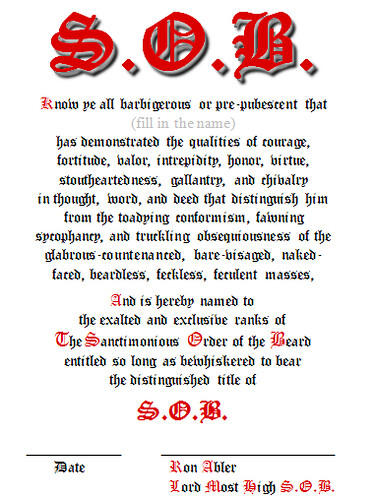
To read the earlier E-Sylum article, see: SOBS TO GET TOGETHER IN CALGARY (www.coinbooks.org/esylum_v15n29a10.html)
Missing Sections of SCWC 1901-2000
 As noted earlier, some country listings were left out of the recent 40th edition of the Standard Catalog of World Coins 1901-2000.
As a fix Krause Publications posted .PDF files of the sections on the Numismaster web site.
James HIgby had trouble finding the files but Scott Tappa of Krause kindly forwarded the following link. Thanks!
As noted earlier, some country listings were left out of the recent 40th edition of the Standard Catalog of World Coins 1901-2000.
As a fix Krause Publications posted .PDF files of the sections on the Numismaster web site.
James HIgby had trouble finding the files but Scott Tappa of Krause kindly forwarded the following link. Thanks!
These sections are included:
- China, Japanese Puppet States
- China, Republic of, & Taiwan
- Congo Democratic Republic
- Panama
- South Georgia & the South Sandwich Islands
- South Arabia
- Southern Rhodesia
- Spain, Spain Civil War
To access the .PDF files, see: www.numismaticnews.net/2013-standard-catalog-of-world-coins-1901-2000
COINS FOUND AT SITE OF DE SOTO'S 1539 FLORIDA ENCAMPMENT
Archaeologist Ashley White is following historical bread crumbs left behind nearly 500 years ago.
The trail leads to a site where, in the summer of 1539, Spanish explorer Hernando De Soto and hundreds of his men camped midway between present-day Ocala and Gainesville, archaeologists now believe.
The process of authenticating a historically significant find can be as time-consuming and painstaking as unearthing and cleaning the brittle artifacts buried in the earth.
In this case, it required the help of other archaeologists, historians and experts on Spanish culture in identifying and dating artifacts from the De Soto encampment and a nearby Spanish mission that was founded more than 60 years after De Soto.
The artifacts include coins minted before De Soto's expedition, multi-layered glass beads crafted in Italy during the early 16th century, bits of chain mail armor used by the Spaniard's men to try to protect themselves against Indians, and a mandible and teeth from a pig bred in Spain during the time De Soto set sail for the New World.
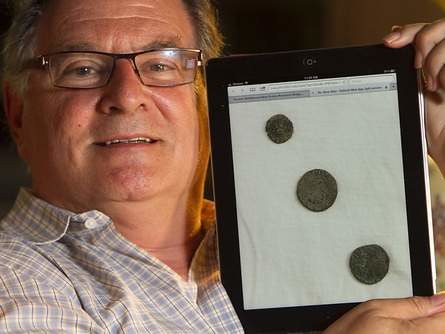
Dr. Stahl with images of the coins on his iPad
For Alan Stahl, curator of numismatics at Princeton University, coins found at archaeological sites are as good as calendars, and three of the many coins White found point to De Soto. They were minted far earlier than coins associated with the Spanish mission period and were found some distance from the mission site, along with other De Soto-era artifacts.
“It was pretty clear what was what,” Stahl said. “Coins are the one aspect of the government of the state that every individual would have come in contact with. Very few people would have met the king, but most people, even in the Middle Ages, had coins with the king's name and image.”
Stahl said coins during De Soto's time stayed in circulation far longer than modern coins. Most rulers didn't mint new copper coins for decades because it cost more to make them than they were worth.
Stahl said he would expect copper coins, rather than gold or silver, to be found at an archaeological site.
“If you had a gold coin and you dropped it, chances are you would pick it up. You would go back and dig it up even if you dropped it in a latrine,” Stahl said.
Copper coins blended with the color of soil and weren't as easily found, or worth looking for.
Stahl said coins were hauled along in expeditions because soldiers and workmen had to be paid.
Jerald Milanich is a De Soto expert, curator emeritus in archaeology of the Florida Museum of Natural History and author of books about De Soto and the Florida Indians.
For Indians, the currency was glass, not coins, and some of the beads White found matched those De Soto would have given to Indians, Milanich said.
To read the complete article, see: Verifying a local archaeologist's De Soto discovery (www.gainesville.com/article/20120708/ARTICLES/120709675)
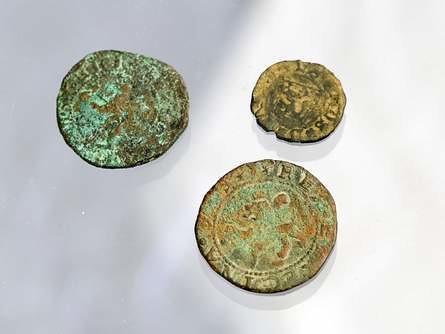
Three copper coins have been registered in the Florida archives. Two bear the likeness of Ferdinand and Isabella. The mint is uncertain but was likely between 1497 and 1504. They were cuarto de 4 maravedi, a small denomination that could be used to buy two eggs or a loaf of bread.
The other coin bears the likeness of Enrique IV and can be dated to between 1454 and 1474. It also is a small-denomination coin.
To read the complete article, see: Artifacts: The De Soto site (www.gainesville.com/article/20120707/ARTICLES/120709697)
STOLEN VALOR RULING PROMPTS CREATION OF MEDAL DATABASE
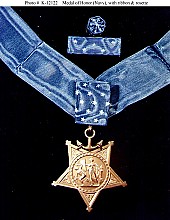 The Pentagon plans to establish a searchable database of military valor awards and medals, hoping for a technological fix to the problem of people getting away with lying about earning military honors.
The Pentagon plans to establish a searchable database of military valor awards and medals, hoping for a technological fix to the problem of people getting away with lying about earning military honors.
Pentagon press secretary George Little said details have yet to be worked out, but the intention is to have a digital repository of records on a range of valor awards and medals going back as far in history as possible.
The move is in response to a June 28 Supreme Court ruling that invalidated a law making it a crime to lie about receiving the Medal of Honor and other military decorations. An authoritative database would make it easier to check on award claims, and perhaps would deter some who would make false public claims.
The high court ruled that the 2006 Stolen Valor Act infringes upon speech protected by the First Amendment.
Veterans organizations and some in Congress have long argued that the Pentagon needs such a database. As recently as 2009 the Pentagon argued that it would be too costly and could pose Privacy Act problems. It also argued that any government database would be incomplete because a 1973 fire at the National Personnel Records Center in St. Louis destroyed millions of personnel records, including those citing medals and awards, and that even a complete database would do little to reduce the number of false award claims.
The Veterans of Foreign Wars of the U.S., which had expressed sharp disappointment in the Supreme Court ruling, believes that publicizing the false claims of military valor can be an effective deterrent to others.
VFW spokesman Joe Davis said Tuesday that his group welcomes the Pentagon’s new approach.
“There are some complexities involved in looking back into history,” Little said. “We would obviously hope to be able to go as far back as possible, but we also want there to be integrity in the data. So these are factors that are being weighed, and we’re in the process of exploring those options. So the door is open.”
To read the complete article, see: Prompted by high court’s “Stolen Valor” ruling, Pentagon to set up database of valor awards (www.washingtonpost.com/politics/prompted-by-high-courts-stolen-valor-ruling-pentagon-to-set-up-database-of-valor-awards/2012/07/10/gJQAhXVBbW_story.html)
To read the earlier E-Sylum article, see: QUERY: IS IT STILL ILLEGAL TO BUY AND SELL MEDALS OF HONOR? (www.coinbooks.org/esylum_v15n28a17.html)
DAVID GANZ ON LEGAL TENDER AND SPENDING MONEY
You recently posted a “legal tender” story about Canadian coins hard on the heels of a story of a man who paid his last mortgage installment in “pennies” or one cent coins. The bank could have refused to accept the cent (which has been legal tender to the nominal value of 25 cents since passage of the Coinage Act of 1873 – the 1982 amendment left it out but claimed to be making no substantive difference), but chose not to.
What this really asks is, "what is a legal tender coin or piece of paper money, and what does the term really mean?"
Two recent events bring this to the forefront.
Back in 2006, a letter to the editor in the Huntsville (Alabama) Times recited how a person "was recently purchasing gas at Kroger on Hughes Road in Madison when I noticed a sign on the pump notifying customers that "rolled coins" and "loose change" could not be accepted as payment. Isn't a business required to accept any form of legal U.S. currency as payment, or can it set its own guidelines for what can be used for payment?"
The answer provided by the newspaper said "No, there is no law that says a merchant must take any particular kind of currency, said Michael White, spokesman for the U.S. Mint. Businesses are free to set their own guidelines as to what they accept as payment, he said." There's an amplification on the Treasury Department's web site. They as the question a different way, but point to the same answers.
On the web site, the party says "I thought that United States currency was legal tender for all debts. Some businesses or governmental agencies say that they will only accept checks, money orders or credit cards as payment, and others will only accept currency notes in denominations of $20 or smaller. Isn't this illegal?"
Responding, Treasury says "The pertinent portion of law that applies to your question is the Coinage Act of 1965, specifically Section 31 U.S.C. 5103, entitled "Legal tender," which states: "United States coins and currency (including Federal reserve notes and circulating notes of Federal reserve banks and national banks) are legal tender for all debts, public charges, taxes, and dues.""
They go on to explain that "This statute means that all United States money as identified above are a valid and legal offer of payment for debts when tendered to a creditor. There is, however, no Federal statute mandating that a private business, a person or an organization must accept currency or coins as for payment for goods and/or services."
Summarizing its position. Treasury goes on to say that "Private businesses are free to develop their own policies on whether or not to accept cash unless there is a State law which says otherwise. For example, a bus line may prohibit payment of fares in pennies or dollar bills. In addition, movie theaters, convenience stores and gas stations may refuse to accept large denomination currency (usually notes above $20) as a matter of policy."
Actually, the citations to federal statutory sources are correct, and so are the examples cited – because they are examples of real-life cases that have been decided for the propositions stated. But they ignore the history of what legal tender mans, what in fact "legal tender" really means, and why laws about them were created in the first place.
There are two constitutional issues that are useful to discuss what the words mean. First, is Article I, Section 8 of the Constitution, which provides "The Congress shall have Power ... To coin Money, regulate the Value thereof, and of foreign Coin, and fix the Standard of Weights and Measures...."
Next is from Article I, section 10, which reads, "No state shall ... coin Money' emit bills of Credit; make any Thing but gold and silver Coin a Tender in Payment of Debts...." Courts have consistently held that neither of these provisions of the Constitution renders the country's current money system unconstitutional, staring with the Legal Tender Cases in 1884.
Those cases involved the ultimate political gamble: creation of paper currency at the height of the Civil War, designed to fund the effort. Its inventor: Salmon P. Chase, Secretary of the Treasury. When accomplished, the federal government reportedly had three days in funding in its vaults; thereafter, it printed what it needed.
Not without critics in its time, Lincoln knew that there was an ultimate Supreme Court battle shaping up; so, too, was there a battle over his Emancipation Proclamation. The legacy of his presidency depended on both being sustained, and when Chief Justice Roger Taney died, Lincoln nominated a known abolitionist, Chase, to both sustain the Emancipation and the greenbacks.
In its original appearance before the Court, Chase prevailed in his view; the surprise is that he found his own actions unconstitutional and in a close 5-4 vote, the Court agreed. By now it was the Grant administration; two justices retired; their replacements switched votes on the reargued case, and the power to declare paper money a legal tender was sustained. Legal tender ultimately is the power of compulsion. It means that the government can require you, willingly or not, to accept a type of money that is tendered. That's why state-authorized private banknotes were an ultimate failure and sold at discounted prices that were disparate.
Over the years, there have been many challenges to what legal tender means; few recall that prior to 1857, foreign coins circulated freely in the United States. The act of Feb. 21, 1857, (ch. 56, 11 Stat. 163 ) determined that the legal tender of the Spanish pillar dollar continued but for other foreign coins, legal tender status was denied.
Over the years, even recently, there have continued to be legal challenges to what constitutes a legal tender. In Foret v. Wilson, 725 F.2d 254 (5th Cir.1984), the Court dismissed the plaintiff's argument that only gold and silver coin may be constituted legal tender by the United States.
In another case, Edgar v. Inland Steel Co., 744 F.2d 1276, 1277 (7th Cir.1984) the Court rejected as untenable plaintiff's argument that federal reserve notes were not "money" because they are not backed by gold and silver specie.
The L.R. Nixon v. Phillipoff case (615 F.Supp. 890 (N.D.Ind.1985)) found that plaintiff's misinterpreted the Constitution, and held that the organic document acts only to "remove from the states the inherent sovereign power to declare currency, thus leaving Congress the sole declarant of what constitutes legal tender").
In another case, Baird v. Cty. Assessors of Salt Lake & Utah Ctys., 779 P.2d 676 (Utah 1989) the Court found that the Constitution is not a directive to states to use only gold or silver coins, but is "merely a restriction preventing states from establishing their own legal tender other than gold or silver coins".
A more current and definitive case is Nemser v N.Y Transit Authority (530 NYS2d 493)(NY Co. 1988), where two public spirited bus riders in New York City brought a proceeding seeking a declaratory judgment that the policy of the Transit authority in refusing to accept dollar bills as bus fare violates federal and state law. (They lost that argument, too). The Judge, a respected jurist, did some research and found a 1911 Rhode Island case involving a street car conductor who refused to accept a $5 bill for a five cent fare. "That Court cited the "incidental power of a common carrier to establish reasonable rules regulating the time, place, and mode for payment of its reasonable charges"," Judge David B. Saxe wrote in his 1989 opinion.
That misses the real point, though.
The compulsion of legal tender is not that you get change – just that you have to accept what is tendered, and for a Court to hold to the contrary, I submit, is simply erroneous and ignores both the history of legal tender and its purpose.
I made those arguments when the Nemser case hit the appellate courts (it didn't do any good, two other courts affirmed the decision) in a friend of the Court brief that two large non-profit organizations filed.
When the Coinage Act of 1965 was passed, it had an important clause that ratified the legal tender status of all American coins and currency previously produced (thus finally legalizing the trade dollar).
In the hearing held June 4, 1965, Rep. Wright Patman, chair of the House Banking & Currency Committee, asked Treasury secretary Henry Fowler whether the coins being authorized "will have the stamp of the United States recognizing that each coin is legal tender for all debts, public and private" to which Fowler replied in the affirmative.
On page 20-21 of the hearing, Fowler was asked "if they have something owing to them, they are compelled by law to accept these coins" to which Fowler answered "Correct". Money becomes a commodity; paper currency a medium of exchange.
Chairman Patman clarifies "two points on the record" on page 32 of the same hearing. "all coins, all paper money are all of equal value as legal tender. You can pay a million dollar debt with copper cents if you want to. That has not always been true. You can pay any debt with 5-cent pieces or 25 cent pieces, and it makes no difference. It is all acceptable legal tender". Secretary Fowler than acknowledges that some vending machines don't accept half dollars and that some coin-operated vending machines are limited.
On the floor debates, it is further clarified that this is nothing "more than a restatement of existing law."
Congress and the drafters of the Coinage act of 1965 knew the history– Wright Patman, that old populist, certainly did – of how there were different rate and value for different coins – how prices were quoting gold coin, silver coin, federal currency, and local paper money. That's what they wanted to avoid.
Just by way of simple example, the New York Commercial advertiser of July 10, 1863 reported that gold coin was at a 17 percent premium in paper, silver at 10 percent, and nickel at four percent. In "History of the Greenbacks" (1903)100 one cent coins (Copper) had a value of 55 cents in gold; in July, 1862, the paper value of dollars was 86.6 cents in gold, and the metal in 100 nickel cents was quoted at 63.5 cents in paper.
Well, we can flash forward to the almost-present.
On February 15, 2007, Susan B. Anthony’s 187th birthday, the U.S. Mint supplemented the Anthony and Sacagawea small sized dollars in circulation by issuing a golden presidential dollar with the portrait of George Washington, the first of a series of at least 39 coins that will be struck over the next 10 years.
I attended the ceremony at New York’s Grand Central Terminal --“ once owned by Commodore Vanderbilt --“ to watch mint director Edmund Moy introduce the new coin and invite members of the public to step forward and buy them by the roll (limit $250 worth) from six mint employees or per diems at a table-side counter.
Citizens were directed to queue up, advance on line, and then directed to a station numbered 1 through 6 to make the exchange: dollar for dollar. No credit cards or checks accepted, only legal tender money.
I decided two days earlier when learning of the event to have a little fun and experiment with legal tender money. My choice to complete payment: a U.S. trade dollar, made from 1873 to 1885 under authority of the Coinage Act of 1873, the only coin ever struck by the U.S. Mint bearing the stamp “United States of America--“ that was a denomination, but not a legal tender.
With the help of Scott Travers, a New York City dealer and author, Sal Germano, a Hawthorne, N.J. dealer, and p.r. guru Donn Pearlman, I came up with a plan: to offer to pay for the exchange with currency plus a rare American silver dollar made by the U.S. Mint at San Francisco 130 years ago --“ an 1877-S trade dollar in very fine condition.
The trade dollar was authorized by Congress as part of the Coinage Act of 1873. It contains 420 grains of silver weighing 27.22 grams (and containing .7874 troy ounces of silver) compared to the more familiar traditional silver dollar which weighs in at 26.73 grams of silver (.7734 troy ounces).
Trade dollars were used principally for export and were not originally a legal tender. In the mid-1870s, as the price of silver declined, they were worth less than their face value. They had metal value but were not a legal tender.
That all changed with the passage of the Coinage Act of 1965 when Congress decided that “all coins... regardless of when coined or issued--“ are legal tender for all debts, public and private. That included the trade dollar, long thought of as America’s stepchild coin because of its lack of legal tender status.
The Mint’s new presidential coin program is an outstanding one, and the ceremonial exchange of new golden presidential dollars for U.S. coins offers the possibility of redeeming a rare coin’s history by exchanging it one-for-one at its stated face value. . The 1877-S trade dollar coin then retailed for about $150 in very fine condition. The presidential golden dollar sold for $1, its face value, and is also legal tender for all debts, public and private.
The components of what constitutes "currency", the beginning point in legal tender definition, is found in Black's Law Dictionary (4th ed) as an item which does "in fact circulate from hand-to-hand as the medium of exchange."
It may include elements such as legal tender status as common usage. The first key factor relates to the legal tender status is that which connotes that a coin (or currency) may be used for all debts, public and private, public charges, duties, taxes and dues.
Congress took this precise position in 1982 when it revised the U.S. Code to make title 31 (coin and currency) positive law. H. Rep. No. 97-651, 97th Cong., 2nd sess. 148 (1982) (31 USCÂ §5103) makes this clear.
It is true for foreign coinage as well. Even Krugerrands --“ owned primarily for bullion --“ are a legal tender. But this is by virtue of legislative action --“ the South African Mint & Coinage Act No. 78 of 1964, as amended by the South African Mint & Coinage Act of 1966, and the South African Mint & Coinage Further Amendment Act. No. 40 of 1966, §§11 through 12. For the same reason, the Canadian Maple Leaf is a legal tender by virtue of the Currency Exchange Act, Canadian revised Chapter C-39 §4, Schedule 1 (1970) (Amended by Order of the Privy Council No. 3048 (1979)).
The "power to 'coin money'... is a prerogative of sovereignty", something that the U.S. Supreme Court enunciated more than 80 years ago in the case of Ling Su Fan v. US, 218 U.S. 302, 310 (1920) .
Thus, Congress could deny the trade dollar legal tender status (1873) and grant it again (1965). The key was whether or not the mint employee would take the tender. There lay the dilemma – but also the story. Pass on the coin and the Mint declines to accept the trade dollar as legal tender. Accept the coin and the Mint has effectively declared the trade dollar a legal tender
As I moved to the front of the line, my heartbeat quickened. I’m a lawyer, and I have all the legal arguments at my command, but I am nervous anyway. I get to the front, remove my wallet rom my pocket, dole out a $20 bill and four singles and then reached into my jacket pocket and take out a circulated trade dollar and pass it along the table, pushing it to the sales agent..
The Mint employee pulls the coin close, appreciating the beauty of its design, picks it up, puts it down, and pushes it back, saying “very nice--“, but adding “what’s this?--“
I tell him it's an old silver dollar. He tells me it's too valuable to push across the table. I tell him I am giving it for the 25th dollar to exchange for a $25 roll of coins. I add, “it’s worth $120--“. He looks at the trade dollar again, and accepts it, handing over a roll of uncirculated 2007-P Washington presidential dollars.
Game, set, but not quite match.
“You sure?--“ the Mint employee says? “Yup,--“: I respond, $119 lighter for the exchange, but confident that the first trade dollar to be exchanged, as legal tender, possibly ever has just taken place --“ with the U.S. Mint, to boot!
To read the earlier E-Sylum articles, see:
THE DIFFERENCE BETWEEN LEGAL TENDER AND SPENDING MONEY
(www.coinbooks.org/esylum_v15n29a22.html)
MAN PAYS OFF MORTGAGE IN CENTS
(www.coinbooks.org/esylum_v15n29a23.html)
THE BOOK BAZARRE
BANK OF PORTUGAL 20 ESCUDOS BANKNOTE AND MEDAL
In past issues of The E-Sylum there have been discussions about coins represented on banknotes and on other items such as glass. Also stamps on coins, and other combinations were discussed. I recently bought a example of a banknote represented on a medal. For me this was a first. Bank of Portugal 20 escudos
The banknote in question was a Bank of Portugal 20 escudos note of 1915. Apparently this is a scarce and important note from the period of the first Portuguese Republic. That was an unstable period in the history of Portugal. In a period of 16 years (1910-1926) Portugal had 8 presidents,1 provisional government, 38 prime ministers and 1 Junta. The only illustration of this note I could find was this low grade example which is being offered on eBay for $3400. Notice that the note has a watermark of a woman's head inside the upper right circle. I should say that I do not collect paper money.
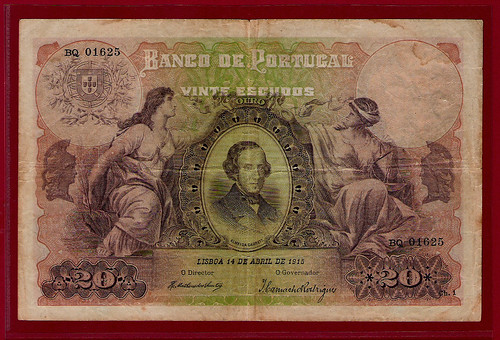
As for the medal, it is a large format gilded bronze medal (4.7" x 3.1") (15.3oz). To me it is real eye candy. The designer of the medal is Cabral Antunes. He designed many medals, and there are a few dozen currently being offered for sale on eBay from the seller: lusitania_express. This example is not in perfect shape, since some of the gilting has rubbed off of some of the anatomical high points. And, notice how you can see the well rendered watermark in the upper right hand corner even without holding the medal up to the light!
The word OURO (gold) appears as the central theme on the banner presented by the two ladies. This seems to be an attempt by the central bank to assure the true value of the banknote - always a problem when introducing new paper money to the public.

The medal is not particularly scarce as you can see from the serial number which is hand stamped on the bottom edge of my medal (#438 of 500).
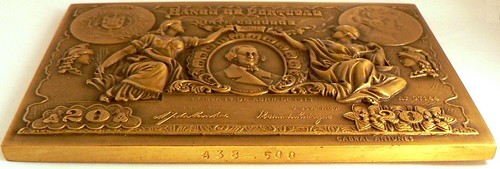
The reverse of the medal reveals the occasion in 1977 for which the medal was issued. As best Google and I could translate it reads: first annual national exposition for collectors of paper money (NOTAFILIA). It also had tables at the show for a broader range of collector area interest, such as Filatelica (stamps), Numismatica (coins), Medalhistica (medals), and Filumenismo (match boxes). I resisted smirking at the last one when I remembered how, when I was the bourse chairman for a club show many years ago, I could not sell all 20 tables so I had to allow other hobby tables. In my case this even included a woman selling cabbage patch dolls. I still regret that - sorry to my fellow numismatists back there in Newport, RI.
I wonder if this paper money show survived beyond this "first annual" show?
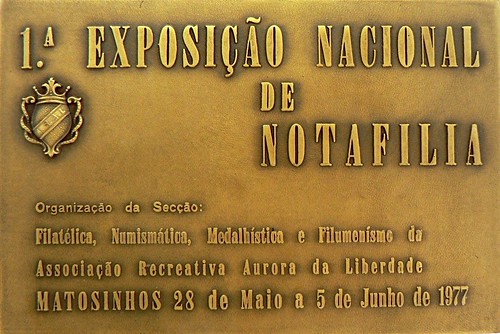
REVIEW: THE NEW PHILADELPHIA MINT EXHIBIT AND TOUR
 I visited the Philadelphia Mint on Saturday. After passing through the security checkpoint, the self-guided tour began at the bottom of an escalator, with a display of both present and historic gold coins, bullion coins, and commemoratives.
I visited the Philadelphia Mint on Saturday. After passing through the security checkpoint, the self-guided tour began at the bottom of an escalator, with a display of both present and historic gold coins, bullion coins, and commemoratives.
After ascending two escalators, and walking down a long corridor, I reached the famous hallway overlooking the production floor. It was immediately clear that this area had been revamped.
Colorful placards positioned along the hallway between the large windows showed the various stages of the coin-production process: Art, Die Making, Blanking, Annealing & Upsetting, Striking, Inspecting, and Bagging.
Though there was not much activity on the production floor because it was the weekend, the exhibit material interspersed throughout the tour made up for it.
In the center of the hallway was a giant spool of coining metal that was partially unrolled and formed into a railing of sorts. Mounted on the walls were master hubs (engraved and blank), obverse and reverse dies (examples that had and had not been struck), collars (with and without reeds), blanks, planchets, and finished coins.
All these materials were mounted in a way that encouraged visitors to touch them and observe closely. The electronic touch-screens (all but one were operational) allowed visitors to explore the production floor in detail.
After the circulating coin exhibit came the exhibit on the production of medals and commemorative coins. As I gazed into the dark medal-production room, a cart of about 500 3-inch medals with a handwritten sign “Annealed and ready for second strike” caught my eye. There was also a nice display of Indian Peace Medals and Presidential Medals.
Back down one escalator into an area labeled the “Mezzanine” was a selection of artifacts: historic coins, medals, hobo nickels, old coining presses, iron gates from the 1901 Philadelphia mint, and Peter, the stuffed U.S. Mint eagle.
Suffice it to say, as someone who is reasonably familiar with the coining process, and someone who has been to the mint in the past, I still enjoyed the tour. Children and adults who were unfamiliar with the process were notably excited.
The designers of the new tour did a good job. It is much better than the former; the process is presented in an intuitive and hands-on fashion, and the number, scope, and presentation of artifacts has been improved. If you are in the area, or within a reasonable distance, you probably would enjoy a visit.
To read the earlier E-Sylum article, see: REVAMPED PHILADELPHIA MINT EXHIBIT AND TOUR OPENS (www.coinbooks.org/esylum_v15n28a24.html)
WAYNE'S NUMISMATIC DIARY: JULY 15, 2012
On Monday I got an email from a numismatic friend from my Pittsburgh days - Dr. Lawrence Korchnak. Larry is a fellow member of the Western Pennsylvania Numismatic Society, and he and his wife were in town for the week to visit with their grandchildren. He wondered if we could get together some evening. I said, "What are you doing tomorrow night?"
Tuesday was the regular dinner meeting of Nummis Nova, my Northern Virginia numismatic social group. As it happened we were meeting just a couple miles from Larry's son's house and he was able to join us. So when I walked into the Best of Thai restaurant in Fairfax, there was Larry already sharing conversation with the group.
Larry was seated next to our host Mike Packard, and I sat across from him. To my right was Roger Burdette. Other attendees were Eric Schena, Jon Radel, Joe Levine, Ron Abler, Tom Kays, Chris Neuzil, and Dave Schenkman.
Larry's specialty is siege coins. He has quite an impressive collection, and is a regular contributor to the Krause Standard Catalog of World Coins. He recently retired after 44 years as an educator, including stints as Superintendent of the Hampton and Baldwin-Whitehall school districts near Pittsburgh. He's looking forward to devoting time to completing the manuscript for a book on world siege coins based on his collection. He sent me a couple images. QUICK QUIZ: who can identify these coins?

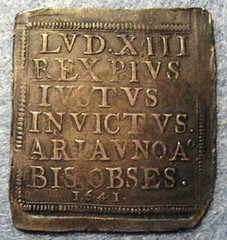
He also mentioned a siege closer to home. Larry writes:
The siege of Vicksburg produced "The Daily Citizen" on wallpaper when they ran out of newsprint. And, the Union soldiers "reprinted" the final July 4 edition with some editing to indicate that Grant defeated the Confederate Army at Vicksburg.
Larry's manuscript wasn't the only one discussed at the dinner. Roger showed us a draft of a book he's working on about the U.S. pattern and experimental coinage of WWII, and Eric Schena passed around a copy of a manuscript he's working on about the Ingle System scrip tokens. Dave Schenkman passed around a box full of salesman's samples of Ingle System tokens. Eric Schena had a 1-cent cardboard token from Harrisonburg, VA.
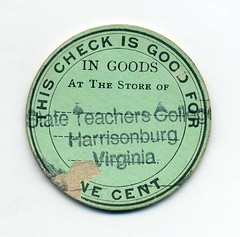
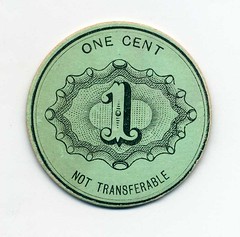
Eric writes:
These tokens came from a former employee of what is now James Madison University and were used in the cafeteria. The college started out as a state normal school, then became a state teacher's college in 1924 until 1938 when it was renamed JMU. The tokens were made by Cussons, May & Sheppard in Glen Allen, VA.
I walked out to my car and dragged in a heavy box of items for the kids at the upcoming Annandale Coin show (July 28-29). Jon Radel and I looked thru it so we can get organized for the kids event. I'd picked it up from show organizer Wayne Herndon's wife Karin on my way to the restaurant.


Jon showed me a medal picturing a fisherman and a large fish. I had never seen it before and had no idea what it was. Jon kindly send me an image for The E-Sylum. I toyed with the idea of making it a quiz, but figured it was too hard. So here's the answer - the piece commemorates the second Cod War between Britain and Iceland. Now watch 15 E-Sylum readers say, "I knew that all along..."
When I got back to my seat I told Larry and Roger, "I know how I'm going to headline this in The E-Sylum - "Jon's Codpiece!".
Jon writes:
On 1 September 1972, amid concerns about overfishing and the status of the national fishing industry, Iceland unilaterally declared that their Exclusive Economic Zone (EEZ) now extended out to 50 nautical miles, excluding foreign fishing ships.
In 1958, Iceland had made a similar extension from 4 nautical miles to 12 nautical miles, which had resulted in the First Cod War with the UK. That had been settled with a stipulation that any further disputes would be sent to the International Court of Justice. In 1972, Iceland declared that it was not bound by the settlement, which rather predictably led to the Second Cod War with the UK. Some ships were rammed, and lots of British nets were cut.
While I do not know the intent of the issuer of this medal, it does commemorate the action that started the Second Cod War, a somewhat "in your face" statement.
Larry Korchnak offered a link to a short history of the Cod Wars. Thanks!
The First Cod War
The first "war" occurred in 1958, when Britain was unable to prevent Iceland, from extending it's fishing limits, from 4 miles, to 12 miles, off Iceland's coast.
The Second Cod War
The second dispute was in 1972-1973, when Iceland extended its limits to 50 miles. This conflict was concluded with an agreement between the two countries that limited British fishing, to certain areas, would be allowed inside the 50-mile limit. In addition, Britain agreed that British vessels could not catch more than 130,000 tons of fish annually. This agreement was valid for two years and expired on November 13 1975, when the third "Cod War" started.
The Third Cod War
Between November 1975, and June 1976, the cod, a common species of fish, brought two NATO allies to the brink of war. Great Britain and Iceland confronted each other over Iceland proclaiming its authority over the ocean, up to 200 miles from its coastline. The issue was the amount of cod caught by the two countries' fishermen.
During this conflict, British trawlers had their nets cut by Icelandic Coast Guard vessels and there were numerous rammings between Icelandic ships and British trawlers and frigates. The conflict caused Iceland to threaten to close the NATO base at Keflavik, which would have imperiled the NATO ability to defend the Atlantic from Soviet incursions
To read the complete webpage, see: The Cod Wars (www.britains-smallwars.com/RRGP/CodWar.htm)
It was another fun and interesting night. Numismatists make great dinner companions. I'm already looking forward to our next meeting.
MORE ON MEDAL CABINET LINING MATERIALS
An alternative I use for lining drawers in a steel cabinet I use for larger items is an archival paper that absorbs environmental contaminants (completely different technology than Intercept Shield) and is faced on one side with a non-buffered cotton layer. There are some concerns in the archival field that metals in direct contact with a buffered paper are at risk of corroding when in contact with the salts that can form as acids are neutralized, hence the production of a paper faced with cotton. It's called MicroChamber/Silversafe Enclosure Paper. (No, I suspect they were more thinking of silver-based film and the like, and not silver coins.)
See www.conservationresources.com/Main/section_15/section15_14.htm for more on the specific product.
See www.conservationresources.com/Main/S%20CATALOG/MicroChamber.htm for more on the technology.
They have various other products I find handy. For example, I make information slips for flips out of one of their archival papers.
I find the scraps that result from cutting the sheets down to drawer size handy for making index tabs to fit in my 2x2 Intercept Shield boxes.
I'm still working on a truly satisfactory way of keeping all the items from shifting around, just a bit, in the drawers as I move them in and out....
To read the earlier E-Sylum article, see: MEDAL CABINET LINING MATERIAL (www.coinbooks.org/esylum_v15n29a09.html)
CRUSADERS' GOLD COIN HOARD FOUND IN ISRAEL
Stephen Pradier writes:
I will never find anything like this.....
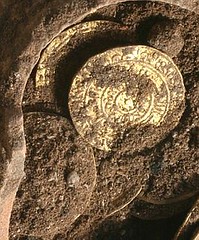 A pot of gold from the Crusades worth up to $500,000 has been found buried in an ancient Roman fortress in Israel.
A pot of gold from the Crusades worth up to $500,000 has been found buried in an ancient Roman fortress in Israel.
The coins were buried by Christian soldiers of the order of the Knights Hospitalier as the Crusaders faced an unstoppable attack by a huge Muslim army. The knights were annihilated in April 1265.
The coins - worth a fortune even in 1265 when they were thought to have been buried - were deliberately hidden inside a broken jug to prevent them being discovered. The fortress was destroyed in April 1265 by forces of Mamluks who overwhelmed the Crusaders - and the treasure only survived due to the quick thinking of one of the defenders. 'It was in a small juglet, and it was partly broken,' Oren Tal of the University of Tel Aviv told Fox News.
'The idea was to put something broken in the ground and fill it with sand, in order to hide the gold coins within. If by chance somebody were to find the juglet, he won’t excavate it, he won’t look inside it to find the gold coins. Once we started to sift it, the gold came out.' The Roman fortress in Apollonia National Park has yielded a huge number of archaeological treasures - but scientists excavating layer from the thirteenth century were stunned to unearth a literal pot of gold.
The clay container had more than 100 gold dinals from the time when the Crusaders occupied the fortress, originally built by the Romans.
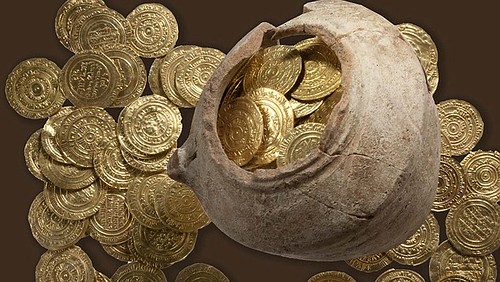
The coins discovered in the fort date to the Fatimid empire in northern Africa, and are 200-300 years older than the ruined fortress they found in. The coins were minted in Tripoli and Alexandria - and are extremely valuable.
'Fatimid coins are very difficult to study,' says Oren Tal, 'The letters are sometimes very difficult to decipher.'
To read the complete article, see:
The Crusaders' last stand: Pot of gold worth £300,000 found in fortress where it was buried by doomed force of Christian knights
(www.dailymail.co.uk/sciencetech/article-2171883/Treasure-Crusaders
-stand-Pot-gold-worth-300-000-fortress-buried-doomed-Christian-knights.html)
The joint team from Tel Aviv University and Israel’s Nature and Parks Authority were working at Apollonia National Park, an ancient Roman fortress on the coast used by the Crusaders between 1241 and 1265, when they literally found a pot of gold.
“All in all, we found some 108 dinals and quarter dinals, which makes it one of the largest gold coin hauls discovered in a medieval site in the land of Israel,” Prof. Oren Tal, chairman of Tel Aviv University’s Department of Archaeology, told FoxNews.com.
Once his team has finished deciphering the coins and decoding their inscriptions, they will be transferred to a museum. But with such a valuable find, there’s already a quarrel between two archaeologically oriented museums over which will host them.
Tal said the Israel Museum in Jerusalem is in the running, as is the Eretz (or Land of Israel) Museum in Tel Aviv.
“Both want the coins on display. It’s not for us to decide,” Tal said.
To read the complete article, see:
Gold coins from time of Crusades found in Israeli ruins
(www.foxnews.com/scitech/2012/07/10/gold-coins-from-time-crusades
-found-in-israeli-ruins/)
And another one from Arthur Shippee (via his Facebook friend Helen Gaudette):
1,000-year-old hoard of gold coins dug up at Crusades site
(www.msnbc.msn.com/id/48154827/ns/technology_and_science-
science/t/-year-old-hoard-gold-coins-dug-crusades-site/)
THE BOOK BAZARRE
URSULA KAMPMANN'S NUMISMATIC VISIT TO JERUSALEM. PART II
To be honest, I would not have noticed that each one, the Bank of Israel and the Israel Antiquities Authority, possesses a coin collection of its own, if Haim Gitler had not told me so. Shame on me!, because these two places keep really important treasures. The Israel Antiquities Authority is specialized on excavated coins, while the exhibition of the Bank of Israel is a must-do to everybody who is interested in Israel’s modern coinage and banknotes.
The history of the Israel Antiquities Authority (IAA) dates back to 1924 when the British founded the British Mandate Antiquities ordinances. After the United Nations General Assembly had decided to realize the division of Palestine into an Arabic and a Jewish state, the British army withdrew on May 14, 1948. In the very night of the foundation of Israel the young state was declared war by Egypt, Saudi-Arabia, Jordan, Lebanon, Iraq and Syria. This war should continue until far into 1949.
One might think that in these troublesome months the Jewish government had a pile of things to do. However, history and particularly archaeology are of much bigger importance to Israel than to most other countries in the world. Because they touch the aspect of identity and the archaeological reasoning that Israel is the Promised Land of the Jews.
Still during the siege of Jerusalem the Israel Department of Antiquities was founded on July 26, 1948. Its task is to protect the country’s past by excavations and interpretation, but also acting as Cultural Heritage Protection.
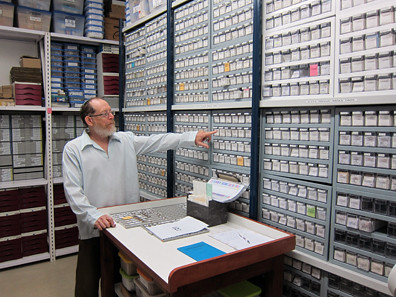
In this safe some 800,000 coins are stored. Every year nearly 8,000 coins are added and identified, described and published. A total of three persons are concerned with the excavated coins.
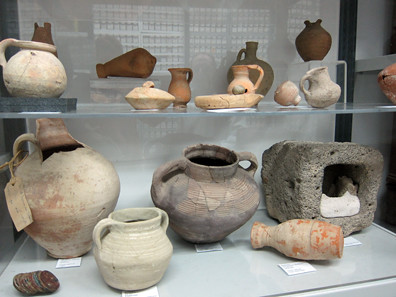
Here they store not only the coins but also the vessels in which the coins had been buried.
To read the complete article, see: Numismatics in Jerusalem – Part 2 (www.coinsweekly.com/en/News/4?&id=1339)
To read the earlier E-Sylum article, see: URSULA KAMPMANN'S NUMISMATIC VISIT TO JERUSALEM (www.coinbooks.org/esylum_v15n29a14.html)
A DANIEL IN THE LION’S DEN MEDAL
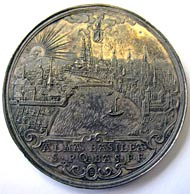
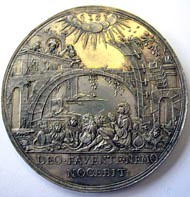
At the end of the Thirty Years War which the Swiss notoriously had not joined in, this splendid medal was made by Friedrich Fecher by order of the government of Basel.
Friedrich Fecher was a native of Strasbourg, where a guild’s list records his name besides the year 1612 and his sign: two F closely put together in a Renaissance shield. Precisely the same sign appears on our medal: below the cartouche with the city name we can see a small shield with the artist’s initials. Fecher came to Basel in 1640. Apparently without being member of any guild in Basel he produced and sold silver and gold implements. Hence the gold and silver guild’s smiths complained about his black labor and achieved finally that he was prohibited to do any more gold and silver work. However, he was able to continue his career as a medal die cutter. To that permission we owe this gorgeous Renaissance medal showing prophet Daniel in the lion’s den.
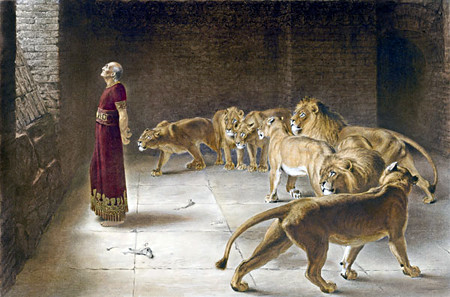
To read the complete article, see:
Prophet Daniel in the lion’s den in Basel
(www.coinsweekly.com/en/Prophet-Daniel-in-the-lions-den-in-Basel/
8?&id=203&type=a)
NEW BRISTOL POUND LOCAL CURRENCY DESIGNS UNVEILED
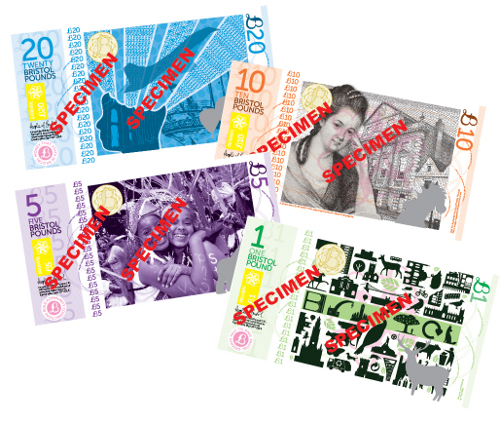
The winning designs for the Bristol Pound notes have been unveiled ahead of the currency’s launch in September.
The £B1, £B5, £B10 and £B20 notes capture different aspects of Bristol’s character – from celebrating its commitment to greener living, its cultural diversity and its creative spirit to its technological heritage.
Hundreds of designs were received from schoolchildren, students, professional designers and amateurs. The winning images were chosen following a rigorous day of judging by a panel representing the city’s creative community.
The notes are now being produced by a specialist printer and will circulate the city in their tens of thousands after the official launch on September 19.
Ciaran Mundy, Director of the Bristol Pound, said: “A local currency for Bristol has been in the pipeline for some time and finalising the paper money designs is one of the final steps.
The Bristol Pound is designed to support independent businesses in and around the city, retaining and multiplying the benefit of every pound spent for ordinary people and businesses. Organisers believe will be the largest of its kind in the UK.
The winning note designs are:
£B20: ‘Balloons’ by Jemima Blench, 10, of Westbury Park Primary School and ‘Concord’ by local artist Kim Short.
£B10: ‘Houses’ by Bristol artist Matt Price and ‘Hannah Moore & Bristol Old Vic’ conceived by Anthea Page and designed by Juraj Prodaj.
£B5: ‘St. Paul’s Carnival’ by photographer Mark Simmons and ‘Graffiti tiger’ by Alex Lucas.
£B1: ‘Bicycle’ by Bristol illustrator Jethro Brice and a design by Phil West. Mr Mundy added: “As more and more shoppers and businesses spend the Bristol Pound, it will keep more of people’s hard earned wages in our communities to be spent again. People in Bristol who love the range of independent traders will be putting their money where it matters and reduce the need for lorries constantly moving goods up and down the country.
“The scheme is also a powerful way to promote local businesses trading with each other. We are hopeful we’ll have thousands signed up before the currency goes in to circulation in the middle of September.”
To read the complete article, see: Bristol Pound banknote designs unveiled (www.bristol247.com/2012/07/09/bristol-pound-banknote-designs-unveiled-51958/)
The Bristol Pound is real money made for Bristol. It is designed to support independent businesses in and around Bristol, retaining and multiplying the benefit of every pound spent for ordinary people and businesses.
For more information on the Bristol Pound, see bristolpound.org
19TH CENTURY BRAZILIAN PATTERNS STRUCK IN WOOD
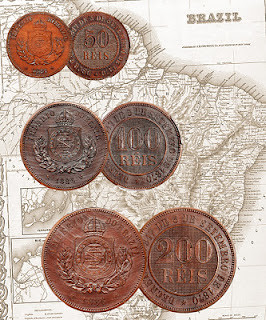
While not among the more valuable coins that cross my desk every week, these patterns are three of the more interesting. They’re the first coins I’ve ever encountered which were struck in wood. A quick Google search brings up the Coinfacts page, but no real information is readily available.
The coins all date 1886, one being a 50 Reis pattern graded SP63 by PCGS (KM-Pn157), the second a 100 Reis pattern graded SP64 by PCGS (KM-Pn158), and the third a 200 Reis pattern graded SP65 by PCGS (KM-PN160). All were recently certified and reside in Secure Plus holders. Perhaps the coolest thing about these coins is the fact that you can see the tree rings on the surface, similar to metal flow lines present in their metal counterparts. The phenomenon is very pronounced on the 200 Reis, slightly less so on the 100 Reis, and significantly less so on the 50 Reis.
All three coins will be offered in our upcoming 2012 August ANA World Sale, in the Internet Only session (that is, session 5) lot numbers 50344, 50345, and 50346 being the 50R, 100R, and 200R pieces respectively.
To read the complete article, see: Crossing The Block: Cool 19th Century Brazilian Patterns Struck In Wood (stacksbowers.com/Blogs/crossing-block-cool-19th-century.html)
AN OPEN LETTER TO THE NEW ANA EXECUTIVE DIRECTOR
Jeff Shevlin, Executive Director
American Numismatic Association
818 N. Cascade Avenue
Colorado Springs, CO 80903
Dear Jeff:
There are very strong forces in existence today that if allowed to continue will ultimately abolish the need and use of coins. Namely, the electronic transfer of money. If we are to see the continued use of coins in the future – of viable coin denominations, the continuance of our hobby with new coin issues, and the sheer existence of numismatics! – there are some actions that must be taken fairly quickly to ensure the abolishment of coin issuing will never happen.
Fortunately we have a strong ally, the vending machine industry. While this industry has continued with inadequate coin denominations – and plagued with problems of paper currency in their machines – they are one of the greatest users of coins in our economy. We assume they would want to continue to use coins in preference to any other system of collecting payments for the small transactions generated by their vending machines.
Therefore I propose the ANA, as the largest coin collectors association in the world, joining forces with the largest trade association of the vending machine industry in America for the purpose studying what coins – denominations and specifications – would be the most viable for future use in America. In effect, establish a Committee for Determining America’s Future Coins.
This committee would determine not only what coin denominations are necessary, but also their specifications – composition, diameter, thickness and such. Further, it could make suggestions as to design but the basic factors are the important considerations since designs can change often.
Organizations which have an influence in Future Coins should be represented on this committee:
ANA – two members
Vending Trade Association – two members
U.S. Treasury Department – one member
U.S. Congress – one member
U.S Mint – one member
Futurist Society – one member.
There is one person whose credentials recommend him to be the chairman of this committee. That person is François Velde. He has written a book on the subject of small coins in world coinage systems and is currently Chief Economist, Chicago Federal Reserve Bank.
For ANA to join with a trade association of the vending machine industry to sponsor such a committee would benefit both fields. It would benefit the numismatic field by insuring the continued, well planned, use of coins far into the future. It would benefit the vending machine field by giving them the most useful coin denominations and a time schedule to reconfigure their machines for the most efficient and profitable use in the future.
Heretofore the Treasury has made coin decisions one situation or crisis at a time. This should be replaced by an overall established plan for the most efficient coinage system covering any circumstance in the future. This should eliminate such actions as issuing a dollar coin near the same diameter as a quarter. Or the continued manufacture of cents and nickels costing more to make than their face value.
Can you make an arrangement with the vending machine trade association to form such a committee?
Respectfully,
D. Wayne Johnson,
Corporate Historian, Medallic Art Co.
ARTISTS USES MONEY ITSELF AS HIS MEDIUM
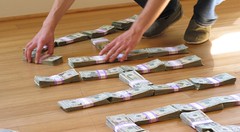 I am kneeling on a sun-dappled hardwood floor with stacks of $20 bills in $2,000 bundles in each hand helping to spell out the word "douchebaggery," and thinking: $220,000 just doesn't seem like that much money. I found myself in this position after asking Matthew Inman, the artist behind the cartoon and business The Oatmeal, if I could take pictures when he withdrew the cash he will ultimately hand over to the American Cancer Society and the National Wildlife Federation in order to use it to make fun of a Web site that threatened him with legal action.
I am kneeling on a sun-dappled hardwood floor with stacks of $20 bills in $2,000 bundles in each hand helping to spell out the word "douchebaggery," and thinking: $220,000 just doesn't seem like that much money. I found myself in this position after asking Matthew Inman, the artist behind the cartoon and business The Oatmeal, if I could take pictures when he withdrew the cash he will ultimately hand over to the American Cancer Society and the National Wildlife Federation in order to use it to make fun of a Web site that threatened him with legal action.
Inman had arranged with his bank a few days before to receive the money at a branch, where they took him into a vault to receive his cash. The bank typically has less than half that amount in cash on hand, a fact that perhaps it shouldn't have shared. He was told to bring four backpacks to hold the cash, but did his own estimations and brought a modest duffel instead.
The more you handle large sums of money, the more ridiculous the concept becomes. A $20 bill, on its own, feels like it has some worth; 1,100 of them are absurd, like confetti or Monopoly bills. There are too many to take seriously. I have this same feeling every time I try to explain to my young children how money and the economy works: "Kids, this piece of paper is different than all others. It's been imbued with magical ink properties and a sort of religious faith in the United States government."
Inman says confronted with the cash in his hands, he's uncomfortable with what he's doing. "It seems boastful," he says, worrying that it is childish spelling out obscenities and insults with hundreds of thousands of dollars on his floor. His buddy says, "When did you stop being willing to be ridiculous, Matt?" "When I turned 29." He is nearly 30 now.
To read the complete article, see: Oatmeal Spells F U in Money Shots (boingboing.net/2012/07/09/oatmeal.html)
FEATURED WEB SITE: NUMISMATIC SOCIETY OF CALCUTTA
This week's Featured Web Site is the Numismatic Society of Calcutta.
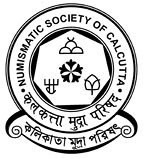 Our Emblem presents some well-known symbols and mintmarks of ancient, early-medieval, medieval and British- Indian coins enclosed within a hexagonal area adopted from the design of our rupee-coin, which itself may have been influenced by the hexagonal English fifty paisa coin of Queen Elizabeth II.
Our Emblem presents some well-known symbols and mintmarks of ancient, early-medieval, medieval and British- Indian coins enclosed within a hexagonal area adopted from the design of our rupee-coin, which itself may have been influenced by the hexagonal English fifty paisa coin of Queen Elizabeth II.
The three-language inscription in the emblem indicated that, though our Society is proud to have seen the light of the day in Calcutta- the premier city in Eastern India, our interests and activities embrace the whole of India, and aspire to reach out and touch the wider world. In short, the Emblem reflects the scope of the society’s quest for knowledge of Numismatics, which covers the whole gamut of Indian history - from the ancient to the modern, and yet does not overlook those of other regions. Sri Pankaj Sarkar designed the emblem with the thoughts and direction of Prof. Roma Neogi.

www.nsckolkata.com
